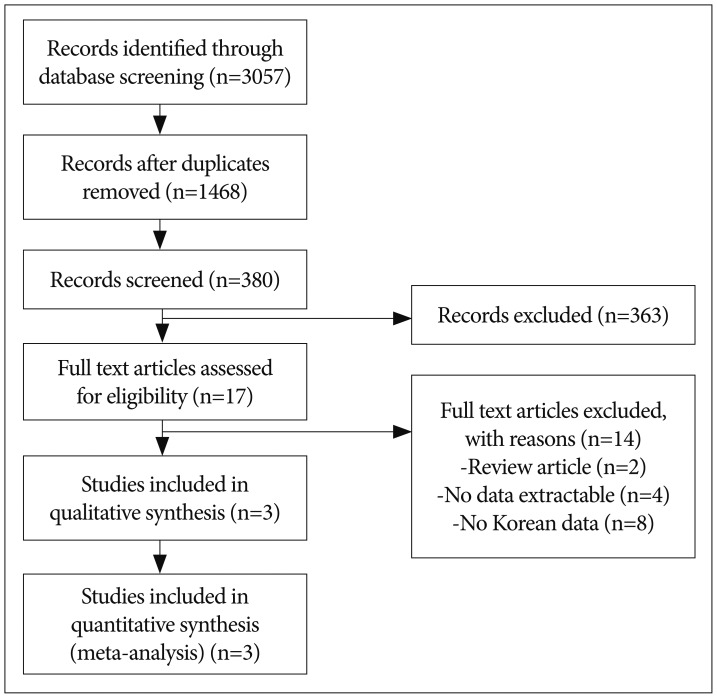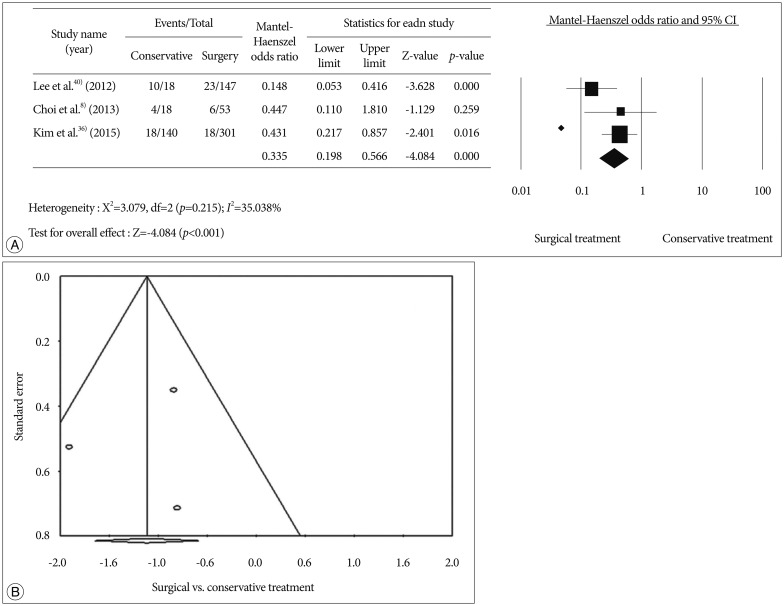A Recent Update of Clinical and Research Topics Concerning Adult Moyamoya Disease
- Affiliations
-
- 1Department of Neurosurgery, Hallym University College of Medicine, Chuncheon, Korea.
- 2Department of Neurosurgery, Seoul National University College of Medicine, Seoul National University Hospital, Seoul, Korea. eunkim@snu.ac.kr
- KMID: 2417333
- DOI: http://doi.org/10.3340/jkns.2016.59.6.537
Abstract
- A better understanding of moyamoya disease (MMD), such as natural clinical course, surgical outcomes and research, has been obtained. This review article focuses on an giving an update for adult MMD in the Korean population. In this paper, we mainly discuss the results of our domestic investigations including meta-analysis, and related subjects from other countries.
Keyword
Figure
Cited by 3 articles
-
Protected versus Unprotected Carotid Artery Stenting : Meta-Analysis of the Current Literature
Young Dae Cho, Sung-Eun Kim, Jeong Wook Lim, Hyuk Jai Choi, Yong Jun Cho, Jin Pyeong Jeon
J Korean Neurosurg Soc. 2018;61(4):458-466. doi: 10.3340/jkns.2017.0202.001.Meta-Analysis of Endovascular Treatment for Acute M2 Occlusion
Chul Ho Kim, Sung-Eun Kim, Jin Pyeong Jeon
J Korean Neurosurg Soc. 2019;62(2):193-200. doi: 10.3340/jkns.2017.0299.Endovascular Treatment with Intravenous Thrombolysis versus Endovascular Treatment Alone for Acute Anterior Circulation Stroke : A Meta-Analysis of Observational Studies
Chul Ho Kim, Jin Pyeong Jeon, Sung-Eun Kim, Hyuk Jai Choi, Yong Jun Cho
J Korean Neurosurg Soc. 2018;61(4):467-473. doi: 10.3340/jkns.2017.0505.006.
Reference
-
1. Ahn IM, Park DH, Hann HJ, Kim KH, Kim HJ, Ahn HS. Incidence, prevalence, and survival of moyamoya disease in Korea : a nationwide, population-based study. Stroke. 2014; 45:1090–1095. PMID: 24595588.
Article2. Bang OY, Ryoo S, Kim SJ, Yoon CH, Cha J, Yeon JY, et al. Adult moyamoya disease : a burden of intracranial stenosis in east asians? PLoS One. 2015; 10:e0130663. PMID: 26125557.3. Chen JB, Liu Y, Zhou LX, Sun H, He M, You C. Increased prevalence of autoimmune disease in patients with unilateral compared with bilateral moyamoya disease. J Neurosurg. 2016; 124:1215–1220. PMID: 26406790.
Article4. Chen PC, Yang SH, Chien KL, Tsai IJ, Kuo MF. Epidemiology of moyamoya disease in Taiwan : a nationwide population-based study. Stroke. 2014; 45:1258–1263. PMID: 24676775.5. Cho WS, Chung YS, Kim JE, Jeon JP, Son YJ, Bang JS, et al. The natural clinical course of hemodynamically stable adult moyamoya disease. J Neurosurg. 2015; 122:82–89. PMID: 25361479.
Article6. Cho WS, Kim JE, Kim CH, Ban SP, Kang HS, Son YJ, et al. Long-term outcomes after combined revascularization surgery in adult moyamoya disease. Stroke. 2014; 45:3025–3031. PMID: 25184359.
Article7. Choi IJ, Cho SJ, Chang JC, Park SQ, Park HK. Angiographic results of indirect and combined bypass surgery for adult moyamoya disease. J Cerebrovasc Endovasc Neurosurg. 2012; 14:216–222. PMID: 23210050.
Article8. Choi WS, Lee SB, Kim DS, Huh PW, Yoo DS, Lee TG, et al. Thirteen-year experience of 44 patients with adult hemorrhagic moyamoya disease from a single institution : clinical analysis by management modality. J Cerebrovasc Endovasc Neurosurg. 2013; 15:191–199. PMID: 24167799.
Article9. Fujii K, Ikezaki K, Irikura K, Miyasaka Y, Fukui M. The efficacy of bypass surgery for the patients with hemorrhagic moyamoya disease. Clin Neurol Neurosurg. 99(Suppl 2):1997; S194–S195. PMID: 9409436.
Article10. Fujimura M, Sonobe S, Nishijima Y, Niizuma K, Sakata H, Kure S, et al. Genetics and biomarkers of moyamoya disease : significance of RNF213 as a susceptibility gene. J Stroke. 2014; 16:65–72. PMID: 24949311.
Article11. Gross BA, Du R. The natural history of moyamoya in a North American adult cohort. J Clin Neurosci. 2013; 20:44–48. PMID: 23146211.
Article12. Guzman R, Lee M, Achrol A, Bell-Stephens T, Kelly M, Do HM, et al. Clinical outcome after 450 revascularization procedures for moyamoya disease. Clinical article. J Neurosurg. 2009; 111:927–935. PMID: 19463046.
Article13. Hallemeier CL, Rich KM, Grubb RL Jr, Chicoine MR, Moran CJ, Cross DT 3rd, et al. Clinical features and outcome in North American adults with moyamoya phenomenon. Stroke. 2006; 37:1490–1496. PMID: 16645133.
Article14. Han H, Pyo CW, Yoo DS, Huh PW, Cho KS, Kim DS. Associations of moyamoya patients with HLA class I and class II alleles in the Korean population. J Korean Med Sci. 2003; 18:876–880. PMID: 14676447.
Article15. Hong SH, Wang KC, Kim SK, Cho BK, Park MH. Association of HLA-DR and -DQ genes with familial moyamoya disease in Koreans. J Korean Neurosurg Soc. 2009; 46:558–563. PMID: 20062572.
Article16. Houkin K, Kamiyama H, Abe H, Takahashi A, Kuroda S. Surgical therapy for adult moyamoya disease. Can surgical revascularization prevent the recurrence of intracerebral hemorrhage? Stroke. 1996; 27:1342–1346. PMID: 8711799.17. Im SH, Cho CB, Joo WI, Chough CK, Park HK, Lee KJ, et al. Prevalence and epidemiological features of moyamoya disease in Korea. J Cerebrovasc Endovasc Neurosurg. 2012; 14:75–78. PMID: 23210031.
Article18. Imai H, Miyawaki S, Ono H, Nakatomi H, Yoshimoto Y, Saito N. The importance of encephalo-myo-synangiosis in surgical revascularization strategies for moyamoya disease in children and adults. World Neurosurg. 2015; 83:691–699. PMID: 25655688.
Article19. Jang DK, Lee KS, Rha HK, Huh PW, Yang JH, Park IS, et al. Clinical and angiographic features and stroke types in adult moyamoya disease. AJNR Am J Neuroradiol. 2014; 35:1124–1131. PMID: 24384121.
Article20. Jeon JP, Kim JE. NMR-based metabolomics analysis of leptomeningeal carcinomatosis. Neurosurgery. 2014; 75:N12–N13.
Article21. Jeon JP, Yun T, Jin X, Cho WS, Son YJ, Bang JS, et al. 1H-NMR-based metabolomic analysis of cerebrospinal fluid from adult bilateral moyamoya disease : comparison with unilateral moyamoya disease and atherosclerotic stenosis. Medicine (Baltimore). 2015; 94:e629. PMID: 25929894.22. Jeon JS, Ahn JH, Moon YJ, Cho WS, Son YJ, Kim SK, et al. Expression of cellular retinoic acid-binding protein-I (CRABP-I) in the cerebrospinal fluid of adult onset moyamoya disease and its association with clinical presentation and postoperative haemodynamic change. J Neurol Neurosurg Psychiatry. 2014; 85:726–731. PMID: 24292994.
Article23. Jeon JS, Sheen SH, Hwang GJ, Kim HC, Kwon BJ. Feasibility of intravenous flat panel detector CT angiography for intracranial arterial stenosis. AJNR Am J Neuroradiol. 2013; 34:129–134. PMID: 22936094.
Article24. Kang HS, Kim JH, Phi JH, Kim YY, Kim JE, Wang KC, et al. Plasma matrix metalloproteinases, cytokines and angiogenic factors in moyamoya disease. J Neurol Neurosurg Psychiatry. 2010; 81:673–678. PMID: 19965844.
Article25. Kang HS, Kim SK, Cho BK, Kim YY, Hwang YS, Wang KC, et al. Single nucleotide polymorphisms of tissue inhibitor of metalloproteinase genes in familial moyamoya disease. Neurosurgery. 2006; 58:1074–1080. discussion 1074-1080. PMID: 16723886.
Article26. Kang HS, Wang KC, Kim SK. Circulating vascular progenitor cells in moyamoya disease. J Korean Neurosurg Soc. 2015; 57:428–431. PMID: 26180610.
Article27. Kawaguchi S, Okuno S, Sakaki T. Effect of direct arterial bypass on the prevention of future stroke in patients with the hemorrhagic variety of moyamoya disease. J Neurosurg. 2000; 93:397–401. PMID: 10969936.
Article28. Kelly ME, Bell-Stephens TE, Marks MP, Do HM, Steinberg GK. Progression of unilateral moyamoya disease : a clinical series. Cerebrovasc Dis. 2006; 22:109–115. PMID: 16685122.
Article29. Kim DS, Huh PW, Kim HS, Kim IS, Choi S, Mok JH, et al. Surgical treatment of moyamoya disease in adults : combined direct and indirect vs. indirect bypass surgery. Neurol Med Chir (Tokyo). 2012; 52:333–338. PMID: 22688071.
Article30. Kim EH, Yum MS, Ra YS, Park JB, Ahn JS, Kim GH, et al. Importance of RNF213 polymorphism on clinical features and long-term outcome in moyamoya disease. J Neurosurg. 2016; 124:1221–1227. PMID: 26430847.
Article31. Kim JE, Jeon JS. An update on the diagnosis and treatment of adult Moyamoya disease taking into consideration controversial issues. Neurol Res. 2014; 36:407–416. PMID: 24641716.
Article32. Kim JE, Kim KM, Kim JG, Kang HS, Bang JS, Son YJ, et al. Clinical features of adult moyamoya disease with special reference to the diagnosis. Neurol Med Chir (Tokyo). 2012; 52:311–317. PMID: 22688068.
Article33. Kim SJ, Heo KG, Shin HY, Bang OY, Kim GM, Chung CS, et al. Association of thyroid autoantibodies with moyamoya-type cerebrovascular disease : a prospective study. Stroke. 2010; 41:173–176. PMID: 19926842.
Article34. Kim SK, Yoo JI, Cho BK, Hong SJ, Kim YK, Moon JA, et al. Elevation of CRABP-I in the cerebrospinal fluid of patients with Moyamoya disease. Stroke. 2003; 34:2835–2841. PMID: 14605320.
Article35. Kim T, Lee H, Bang JS, Kwon OK, Hwang G, Oh CW. Epidemiology of moyamoya disease in Korea : based on national health insurance service Data. J Korean Neurosurg Soc. 2015; 57:390–395. PMID: 26180604.
Article36. Kim T, Oh CW, Kwon OK, Hwang G, Kim JE, Kang HS, et al. Stroke prevention by direct revascularization for patients with adult-onset moyamoya disease presenting with ischemia. J Neurosurg. 2016; 124:1788–1793. PMID: 26636391.
Article37. Kuriyama S, Kusaka Y, Fujimura M, Wakai K, Tamakoshi A, Hashimoto S, et al. Prevalence and clinicoepidemiological features of moyamoya disease in Japan : findings from a nationwide epidemiological survey. Stroke. 2008; 39:42–47. PMID: 18048855.
Article38. Kuroda S, Hashimoto N, Yoshimoto T, Iwasaki Y. Research Committee on Moyamoya Disease in Japan. Radiological findings, clinical course, and outcome in asymptomatic moyamoya disease : results of multicenter survey in Japan. Stroke. 2007; 38:1430–1435. PMID: 17395863.
Article39. Kuroda S, Ishikawa T, Houkin K, Nanba R, Hokari M, Iwasaki Y. Incidence and clinical features of disease progression in adult moyamoya disease. Stroke. 2005; 36:2148–2153. PMID: 16179571.
Article40. Lee SB, Kim DS, Huh PW, Yoo DS, Lee TG, Cho KS. Long-term follow-up results in 142 adult patients with moyamoya disease according to management modality. Acta Neurochir (Wien). 2012; 154:1179–1187. PMID: 22476796.
Article41. Lee SC, Jeon JS, Kim JE, Chung YS, Ahn JH, Cho WS, et al. Contralateral progression and its risk factor in surgically treated unilateral adult moyamoya disease with a review of pertinent literature. Acta Neurochir (Wien). 2014; 156:103–111. PMID: 24201757.
Article42. Liu JS, Juo SH, Chen WH, Chang YY, Chen SS. A case of Graves' diseases associated with intracranial moyamoya vessels and tubular stenosis of extracranial internal carotid arteries. J Formos Med Assoc. 1994; 93:806–809. PMID: 7735012.43. Liu W, Morito D, Takashima S, Mineharu Y, Kobayashi H, Hitomi T, et al. Identification of RNF213 as a susceptibility gene for moyamoya disease and its possible role in vascular development. PLoS One. 2011; 6:e22542. PMID: 21799892.
Article44. Liu W, Zhu S, Wang X, Yue X, Zhou Z, Wang H, et al. Evaluation of angiographic changes of the anterior choroidal and posterior communicating arteries for predicting cerebrovascular lesions in adult moyamoya disease. J Clin Neurosci. 2011; 18:374–378. PMID: 21237656.
Article45. Mesiwala AH, Sviri G, Fatemi N, Britz GW, Newell DW. Long-term outcome of superficial temporal artery-middle cerebral artery bypass for patients with moyamoya disease in the US. Neurosurg Focus. 2008; 24:E15.
Article46. Miyamoto S, Yoshimoto T, Hashimoto N, Okada Y, Tsuji I, Tominaga T, et al. Effects of extracranial-intracranial bypass for patients with hemorrhagic moyamoya disease : results of the Japan Adult Moyamoya Trial. Stroke. 2014; 45:1415–1421. PMID: 24668203.
Article47. Miyatake S, Miyake N, Touho H, Nishimura-Tadaki A, Kondo Y, Okada I, et al. Homozygous c.14576G>A variant of RNF213 predicts early-onset and severe form of moyamoya disease. Neurology. 2012; 78:803–810. PMID: 22377813.
Article48. Nicholson JK, Lindon JC. Systems biology : metabonomics. Nature. 2008; 455:1054–1056. PMID: 18948945.49. Paez MT, Yamamoto T. Single nucleotide polymorphisms of tissue inhibitor of metalloproteinase genes in familial moyamoya disease. Neurosurgery. 60:2007; E582. author reply E582.
Article50. Park YS, Min KT, Kim TG, Lee YH, Cheong HJ, Yeom IS, et al. Age-specific eNOS polymorphisms in moyamoya disease. Childs Nerv Syst. 2011; 27:1919–1926. PMID: 21691823.
Article51. Qian C, Yu X, Li J, Chen J, Wang L, Chen G. The efficacy of surgical treatment for the secondary prevention of stroke in symptomatic moyamoya disease : a meta-analysis. Medicine (Baltimore). 2015; 94:e2218. PMID: 26656359.52. Smith ER. Moyamoya biomarkers. J Korean Neurosurg Soc. 2015; 57:415–421. PMID: 26180608.
Article53. Smith ER, Scott RM. Progression of disease in unilateral moyamoya syndrome. Neurosurg Focus. 2008; 24:E17.
Article54. Sun H, Wilson C, Ozpinar A, Safavi-Abbasi S, Zhao Y, Nakaji P, et al. Perioperative complications and long-term outcomes after bypasses in adults with moyamoya disease : a systematic review and meta-analysis. World Neurosurg. 2016; 92:179–188. PMID: 27150649.
Article55. Suzuki J, Takaku A. Cerebrovascular "moyamoya" disease. Disease showing abnormal net-like vessels in base of brain. Arch Neurol. 1969; 20:288–299. PMID: 5775283.



